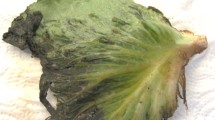Abstract
A distinctively pink soft rot has been repeatedly observed on samples of root parsley (Petroselinum crispum var. tuberosum) from different regions in Germany since 2015, and pink pigmented bacteria were consistently isolated from these roots. As indicated by their biochemical properties and sequences of the gapDH and rpoD genes, the parsley strains were identified as Erwinia persicina, a species closely related to E. rhapontici. In pathogenicity tests, E. persicina was shown to successfully colonise healthy parsley roots after wound inoculation. However, the developing rot was not as pronounced as in the field samples, and other as-yet unknown factors such as environmental conditions, feeding insects, or other pathogenic microorganisms seem to be contributing to symptom expression in parsley roots. As suggested by reisolations performed from the inoculated roots, fresh commercial parsley roots may be latently contaminated with both E. persicina and Pectobacterium carotovorum subsp. carotovorum. The latter in particular might be part of a complex of factors leading to the distinctively severe symptoms observed. The characteristic colour of the affected roots suggests the involvement of E. persicina and the name “pink rot of parsley root” for this previously undescribed disease.


Similar content being viewed by others
References
Abdullah AS, Moffat CS, Lopez-Ruiz FJ, Gibberd MR, Hamblin J, Zerihun A (2017) Host-multi-pathogen warfare: pathogen interactions in co-infected plants. Front Plant Sci 8:1806
Anonymus (2017) Petersilienwurzeln und Pastinaken wieder voll im Trend. Proplanta. https://www.proplanta.de/Agrar-Nachrichten/Pflanze/Petersilienwurzeln-und-Pastinaken-wieder-voll-im-Trend_article1508915495.html. Accessed 01 Aug 2018
Brady C, Cleenwerck I, Venter S, Vancanneyt M, Swings J, Coutinho T (2008) Phylogeny and identification of Pantoea species associated with plants, humans and the natural environment based on multilocus sequence analysis (MLSA). Syst Appl Microbiol 31:447–460
Brown EW, Davis RM, Gouk C, van der Zwet T (2000) Phylogenetic relationships of necrogenic Erwinia and Brenneria species as revealed by glyceraldehyde-3-phosphate dehydrogenase gene sequences. Int J Syst Evol Microbiol 50:2057–2068
Coenye T, Falsen E, Vancanneyt M, Hoste B, Govan JRW, Kersters K, Vandamme P (1999) Classification of Alcaligenes faecalis-like isolates from the environment and human clinical samples as Ralstonia gilardii sp. nov. Int J Syst Bacteriol 49:405–413
Ellers-Kirk C, Fleischer SJ (2006) Development and life table of Acalymma vittatum (Coleoptera: Chrysomelidae), a vector of Erwinia tracheiphila in cucurbits. Environ Entomol 35:875–880
Feistner GJ, Mavridis A, Rudolph K (1997) Proferrorosamines and phytopathogenicity in Erwinia spp. Biometals 10:1–10
Gálvez L, Gil-Serna J, García-Díaz M, Palmero D (2015) First report of a garlic bulb rot caused by Erwinia persicina in Europe. Plant Dis 99:723
González AJ, Tello JC, Rodicio MR (2007) Erwinia persicina causing chlorosis and necrotic spots in leaves and tendrils of Pisum sativum in Southeastern Spain. Plant Dis 91:460
Hall TA (1999) BioEdit: a user-friendly biological sequence alignment editor and analysis program for Windows 95/98/NT. Nucl Acids Symp Ser 41:95–98
Hao MV, Brenner DJ, Steigerwalt AG, Kosako Y, Komagata K (1990) Erwinia persicinus, a new species isolated from plants. Int J Syst Bacteriol 40:379–383
Huang H-C, Hsieh T-F, Erickson RS (2003) Biology and epidemiology of Erwinia rhapontici, causal agent of pink seed and crown rot of plants. Plant Pathol Bull 12:69–76
Huang H-C, Erickson RS, Hsieh T-F (2007) Lack of host specificity of strains of Erwinia rhapontici, causal agent of pink seed of pulse and cereal crops. Bot Stud 48:181–186
Husseneder C, Park J-S, Howells A, Tikhe CV, Davis JA (2017) Bacteria associated with Piezodorus guildinii (Hemiptera: Pentatomidae), with special reference to those transmitted by feeding. Environ Entomol 46:159–166
Johnson LR (1936) Observations on the occurrence of Anguillulina dipsaci (Kühn, 1858) on rhubarb in Yorkshire. J Helminthol 14:77–84
Kumar S, Stecher G, Tamura K (2016) MEGA7: molecular evolutionary genetics analysis version 7.0 for bigger datasets. Mol Biol Evol 33:1870–1874
Lamichhane JR, Venturi V (2015) Synergisms between microbial pathogens in plant disease complexes: a growing trend. Front Plant Sci 6:385
Metcalfe G (1940) Bacterium rhaponticum (Millard) Dowson, a cause of crown-rot disease of rhubarb. Ann Appl Biol 27:502–508
Moretti C, Hosni T, Vandemeulebroecke K, Brady C, De Vos P, Buonaurio R, Cleenwerck I (2011) Erwinia oleae sp. nov., isolated from olive knots caused by Pseudomonas savastanoi pv. savastanoi. Int J Syst Evol Microbiol 61:2745–2752
Ohuchi A, Ohsawa T, Nishimura J (1983) Two pathogenic bacteria, Erwinia rhapontici (Millard 1924) Burkholder 1948 and Pseudomonas marginalis pv. marginalis (Brown 1918) Stevens 1925, causing a soft rot of onion. Ann Phytopathol Soc Jpn 49:619–626
Powell NT (1971) Interactions between nematodes and fungi in disease complexes. Annu Rev Phytopathol 9:253–274
Roberts P (1974) Erwinia rhapontici (Millard) Burkholder associated with pink grain of wheat. J Appl Bacteriol 37:353–358
Sellwood JE, Lelliott RA (1978) Internal browning of hyacinth caused by Erwinia rhapontici. Plant Pathol 27:120–124
Sturhan D, Brzeski MW (1991) Stem and bulb nematodes, Ditylenchus spp. In: Nickle WR (ed) Manual of agricultural nematology. Marcel Dekker Inc., New York, pp 423–464
Veldhoff D (2016) Strategien zur Reduzierung von bakteriellen Krankheiten im bayerischen Gemüsebau. Project report. Bayerisches Staatsministerium für Ernährung, Landwirtschaft und Forsten, München, 51 p
Wensing A, Ullrich M, Gehring I, Geider K (2009) Erwinia rhapontici und E. persicina als geeignete Antagonisten gegen Feuerbrand? J Cultiv Plants 61:380
Zhang Z, Nan Z (2014) Erwinia persicina, a possible new necrosis and wilt threat to forage or grain legumes production. Eur J Plant Pathol 139:343–352
Acknowledgements
The authors wish to thank Melanie Friedrich-Zorn, Bianka Huber and Sigrid Ziegltrum for excellent technical support. Birgit Zange (Hochschule Weihenstephan Triesdorf) and Korbinian Bogner (Bioland e.V.) are acknowledged for the good cooperation during an early phase of the project, and for providing samples.
Author information
Authors and Affiliations
Corresponding author
Ethics declarations
Conflict of interest
All authors declare that they have no conflict of interest.
Rights and permissions
About this article
Cite this article
Nechwatal, J., Theil, S. Erwinia persicina associated with a pink rot of parsley root in Germany. J Plant Dis Prot 126, 161–167 (2019). https://doi.org/10.1007/s41348-018-0200-6
Received:
Accepted:
Published:
Issue Date:
DOI: https://doi.org/10.1007/s41348-018-0200-6




